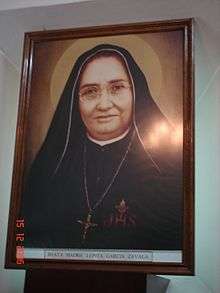María Guadalupe García Zavala
| Saint María Guadalupe García Zavala | |
|---|---|
 | |
| Virgin, Co-Foundress of the Handmaids of St Margaret Mary and the Poor | |
| Born |
27 April 1878 Zapopan, Jalisco, Mexico |
| Died |
24 June 1963 (aged 85) Guadalajara, Jalisco, Mexico |
| Venerated in | Catholic Church |
| Beatified | 25 April 2004, Saint Peter's Square, Vatican City by Pope John Paul II |
| Canonized | 12 May 2013, Saint Peter's Square, Vatican City by Pope Francis |
| Feast | 24 June |
María Guadalupe García Zavala (27 April 1878 – 24 June 1963), also known as "Mother Lupita", was the co-foundress of the Congregation of the Handmaids of St Margaret Mary Alacoque and the Poor and the congregation's first mother superior. She was beatified by Pope John Paul II on 25 April 2004. Her canonization took place on 12 May 2013, along with Antonio Primaldo and his companions and Laura of Saint Catherine of Siena.[1]
Biography
Early life
María Guadalupe García Zavala was born on 27 April 1878 in Zapopan, Jalisco, Mexico, to Fortino García and Refugio Zavala de García. She had a special devotion to Our Lady of Zapopan. Her father was a religious store merchant. His shop was located in front of the Basilica of Our Lady of Zapopan.[2] Hence, she made frequent visits to the Basilica of Our Lady of Zapopan.
Although initially she planned to marry Gustavo Arreola, she broke off her engagement because she felt a call to religious life, and believed that she was called to give assistance to the poor and sick.
New congregation
Along with her spiritual director, Fr Cipriano Iñiguez, she co-founded a new congregation, which they began on 13 October 1901. It was known as the "Handmaids of St Margaret Mary (Alacoque) and the Poor". María worked as a nurse. Regardless of the poverty and lack of material goods of the patients, compassion and care for the physical and spiritual well-being of the sick were the primary concerns of their congregation. María was named Superior General of the quickly growing congregation, and taught the Sisters entrusted to her, mostly by means of her example, the importance of living a genuine and joyful exterior and interior poverty. She was convinced that it was only through loving and living poverty that one could be truly "poor with the poor".
In times of dire need, Mother María asked her spiritual director for permission to go begging in order to collect money for the hospital. Together with other Sisters, she would seek offerings until the needs of the hospital and patients were met, and would ask no more than was necessary.[3] The Sisters also worked in nearby parishes to assist the priests and to teach catechism.
Mexican Revolution
The Mexican Revolution started in 1911 and its effects lasted up-to 1936. during which the political-religious situation in Mexico became uneasy. The Catholic Church underwent persecution. Mother María put her own life at risk and hid the priests and the Archbishop of the Archdiocese of Guadalajara in her hospital.
Death
The last two years of María's life were lived in extreme suffering because of a grave illness . She died on 24 June 1963 at Guadalajara, Jalisco, Mexico at the age of 85. During her lifetime, 11 foundations were established in the Republic of Mexico . Today, the congregation has 22 foundations and is present in five different Nations: Mexico, Peru, Iceland, Greece and Italy.
Sainthood
She was declared as a venerable on 1 July 2000 by Pope John Paul II (decree of heroic virtues ). She was beatified by Pope John Paul II on 25 April 2004, 3rd Sunday of Easter. Her canonization took place on 12 May 2013, along with Antonio Primaldo and his companions and Laura of Saint Catherine of Siena.[4]
See also
References
- ↑ "El Papa declara santa a la 'madre Lupita', la monja de los enfermos". CNN Mexico. 12 May 2013. Retrieved 4 October 2014.
- ↑ Mexico to Have a New Saint – “Mother Lupita” García Zavala
- ↑ María Guadalupe García Zavala (1878–1963)
- ↑ “Saint Anastasia Guadalupe García Zavala“. Saints.SQPN.com. 12 February 2013. Web. 18 February 2013